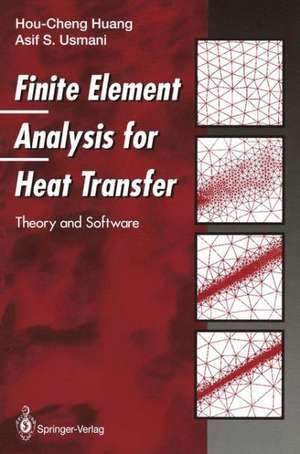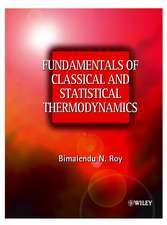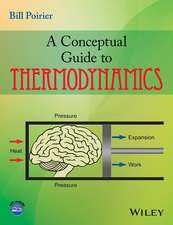Finite Element Analysis for Heat Transfer: Theory and Software
Autor Hou-Cheng Huang, Asif S. Usmanien Limba Engleză Paperback – 4 ian 2012
Preț: 383.50 lei
Nou
Puncte Express: 575
Preț estimativ în valută:
73.41€ • 79.76$ • 61.70£
73.41€ • 79.76$ • 61.70£
Carte tipărită la comandă
Livrare economică 21 aprilie-05 mai
Preluare comenzi: 021 569.72.76
Specificații
ISBN-13: 9781447120933
ISBN-10: 1447120930
Pagini: 216
Ilustrații: XI, 199 p.
Dimensiuni: 155 x 235 x 11 mm
Greutate: 0.31 kg
Ediția:Softcover reprint of the original 1st ed. 1994
Editura: SPRINGER LONDON
Colecția Springer
Locul publicării:London, United Kingdom
ISBN-10: 1447120930
Pagini: 216
Ilustrații: XI, 199 p.
Dimensiuni: 155 x 235 x 11 mm
Greutate: 0.31 kg
Ediția:Softcover reprint of the original 1st ed. 1994
Editura: SPRINGER LONDON
Colecția Springer
Locul publicării:London, United Kingdom
Public țintă
ResearchCuprins
1 Introduction.- 1.1 Importance of Numerical Analysis of Heat Transfer.- 1.2 Reliability of Finite Element Analysis for Heat Transfer.- 1.3 Various Heat Transfer Problems.- 1.4 Objectives and Layout.- References.- 2 Governing Differential Equations.- 2.1 Introduction.- 2.2 Conduction.- 2.3 Convection.- 2.4 Radiation.- References.- 3 Finite Element Method.- 3.1 Introduction.- 3.2 Variational Principle and Rayleigh-Ritz Method.- 3.3 Galerkin Weighted Residual Method.- 3.4 Finite Element Method in Two Dimensions.- References.- 4 Temporal Discretisation for Heat Conduction.- 4.1 Introduction.- 4.2 Finite Element Discretisation of the Transient Conduction Equation.- 4.3 Recurrence Relations.- 4.4 Automatic Time Step Selection.- 4.5 Benchmark Example.- References.- 5 Phase Transformation.- 5.1 Introduction.- 5.2 The Stefan Problem.- 5.3 Numerical Methods for Modelling Phase Transformation.- 5.4 Benchmark Examples.- 5.5 Conclusion.- References.- 6 Adaptive Heat Transfer Analysis.- 6.1 Introduction.- 6.2 Error Estimation for Heat Conduction.- 6.3 Higher Order Approximation.- 6.4 Implementation of the Adaptive Procedure.- 6.5 Steady State Benchmark Example.- 6.6 Transient Analysis.- References.- 7 Effects of Convection in Heat Transfer.- 7.1 Introduction.- 7.2 Steady State Advection-diffusion.- 7.3 Transient Advection-diffusion.- References.- A Software Description for HEAT2D.- A.1 Introduction.- A.2 Glossary of Variable Names.- A.2.1 Main Variables.- A.2.2 Main Arrays.- A.2.3 Main Subroutines.- A.3 Program Overview.- A.4 Input Instructions.- A.5 Element Stiffness Calculations.- A.6 Phase Change Calculations.- A.6.1 Nodal Latent Heat Calculations.- A.6.2 Latent Heat Release for Each Iteration.- A.6.3 Correction of Temperatures after Each Iteration.- A.7 Documented Examples.- A.7.1 1-D Solidification Example.- A.7.2 Steady State Forced Convection Example Using the SUPG Method.- References.- B Software Description for HADAPT.- B.1 Introduction.- B.2 Glossary of Variable Names.- B.2.1 Main Variables for the Geometry and Mesh Data.- B.2.2 Additional Variables Used in This Program.- B.2.3 Additional Arrays Used in This Program.- B.2.4 New Subroutines Used in This Program.- B.3 Program Overview.- B.4 Input Instructions.- B.4.1 Geometry Data.- B.4.2 Mesh Density Data.- B.4.3 Example Data File.- B.4.4 Output Data.- B.4.5 Problem Data.- B.5 Error Estimate Calculations.- B.6 Documented Examples.- B.6.1 2-D Heat Conduction with Convective Boundary Condition.- B.6.2 Convection Dominated 2-D Heat Transfer.- B.6.3 1-D Solidification Example.









